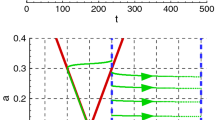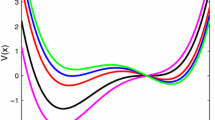Abstract
Presented here is a basic biophysical cell model for bursting, an extension of our previous model (Av-Ron et al. 1991) for excitability and oscillations. By changing a limited set of model parameters, one can describe different patterns of bursting behavior in terms of the burst cycle, the durations of oscillation and quiescence, and firing frequency.
Similar content being viewed by others
References
Av-Ron E, Parnas H, Segel LA (1991) A minimal biophysical model for an excitable and oscillatory neuron. Biol Cybern 65:487–500
Bullock TH, Terzuolo CA (1957) Diverse forms of activity in the somata of spontaneous and integrating ganglion cells. J Physiol (Lond) 138:341–364
FitzHugh R (1961) Impulses and physiological states in theoretical models of nerve membrane. Biophys J 1:445–466
Hille B (1992) Ionic channels of excitable membranes (Second edition). Sinauer, Inc. Sunderland, Mass
Hodgkin AL, Huxley AF (1952) A quantitative description of membrane current and its application to conduction and excitation in nerve. J Physiol (Lond) 117:500–544
Otani T, Bullock TH (1959) Effects of presetting the membrane potential of the soma of spontaneous and integrating ganglion cells. Physiol Zool 32:104–114
Plant RE (1978) The effects of calcium2+ on bursting neurons. Biophys J 21:217–237
Rinzel J (1984) Excitation dynamics: insights from simplified membrane models. Proceedings of 68th Annual Meeting of Federation of American Societies for Experimental Biology, St Louis, Mo
Rinzel J (1987) A formal classification of bursting mechanisms in excitable systems. In: Teramoto E, Yamaguti M (eds) Mathematical topics in population biology, morphogenesis and neurosciences. (Lecture notes in biomathematics, vol 71) Springer, Heidelberg New York, pp 267–281
Rinzel J, Lee YS (1987) Dissection of a model for neuronal parabolic bursting. J. Math Biol 25:653–675
Rinzel J, Ermentrout GB (1989) Analysis of neural excitability and oscillations. In: Koch C, Segev I (eds) Methods in neuronal modeling: from synapses to networks. MIT Press, Bradford, Mass
Schwarz W, Passow H (1983) Ca2+-activated K+ channels in erythrocytes and excitable cells. Annu Rev Physiol 45:359–357
Author information
Authors and Affiliations
Rights and permissions
About this article
Cite this article
Av-Ron, E., Parnas, H. & Segel, L.A. A basic biophysical model for bursting neurons. Biol. Cybern. 69, 87–95 (1993). https://doi.org/10.1007/BF00201411
Received:
Accepted:
Issue Date:
DOI: https://doi.org/10.1007/BF00201411




